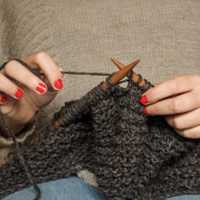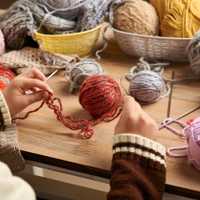How to Perform the Make One - Yarn Over and Bar Increases in Knitting
how to perform the make one - yarn over and bar increases in knitting
How to Perform the Make One - Yarn Over and Bar Increases in Knitting
By Megan Kutchman
How to Perform the Make One - Yarn Over and Bar Increases in Knitting
By Megan Kutchman
There are five common ways to perform the "make one" increasing technique you'll see in some knitting patterns. To make one is to increase your knitting by one stitch. Depending on the pattern, you may be instructed to make one several times in a row. Here are the five ways to increase in knitting:
Knitting into the front and back of one stitch
This will make an increase almost invisible. To do this, begin knitting a stitch like normal, but don't pull the stitch off the left needle. Instead, point your right needle down and toward the back side of the left needle. Insert your right needle (while it's pointing down) into the stitch on the left needle and knit as normal.
Knitting into the stitch below
This is another nearly invisible increase. Knit the stitch below the top stitch on your left needle. This is a more awkward method of increasing and tends to make the stitches tighter if you're not careful while you knit the increase.
Yarn Over
This is the more widely known method of increasing. A yarn over increase will result in a gap in the knitting that looks like a hole. This is useful for making designs in a pattern and is often use in conjunction with a knit two together decrease to make an eyelet pattern. To perform the yarn over increase, wrap the yarn around the needle as you would when knitting a stitch. For example, you can knit a stitch, yarn over, then knit another stitch. The yarn over has to be done between stitches.
Bar Increase
This increase results in either a hole or a right-slanted stitch, depending on how it's done. Hold your knitting project like normal, with a needle in each hand, and you should notice what's called a "bar" between the needles. It's the top strand on the stitch between the needles. To do a bar increase, insert your right needle through the front of this bar and lift it up onto your left needle. Now you can either: -knit into the back of this stitch which will result in a small hole -or knit into the front of the stitch for a right-slanted stitch
Knitted On Cast On Increase
If you're familiar with the knitted on cast on technique, you can increase this way as well. To increase this way, begin as if to knit a stitch but instead of taking the stitch off the left needle, move the newly knitted stitch from your right to your left needle. This will result in a slanted stitch.
Megan Kutchman owns a retail knitting site, http://www.faknitic.com. To learn more about knitting, visit the Knitting Articles resource page on her website.
Article Source: http://EzineArticles.com/?expert=Megan_Kutchman
There are five common ways to perform the "make one" increasing technique you'll see in some knitting patterns. To make one is to increase your knitting by one stitch. Depending on the pattern, you may be instructed to make one several times in a row. Here are the five ways to increase in knitting:
Knitting into the front and back of one stitch
This will make an increase almost invisible. To do this, begin knitting a stitch like normal, but don't pull the stitch off the left needle. Instead, point your right needle down and toward the back side of the left needle. Insert your right needle (while it's pointing down) into the stitch on the left needle and knit as normal.
Knitting into the stitch below
This is another nearly invisible increase. Knit the stitch below the top stitch on your left needle. This is a more awkward method of increasing and tends to make the stitches tighter if you're not careful while you knit the increase.
Yarn Over
This is the more widely known method of increasing. A yarn over increase will result in a gap in the knitting that looks like a hole. This is useful for making designs in a pattern and is often use in conjunction with a knit two together decrease to make an eyelet pattern. To perform the yarn over increase, wrap the yarn around the needle as you would when knitting a stitch. For example, you can knit a stitch, yarn over, then knit another stitch. The yarn over has to be done between stitches.
Bar Increase
This increase results in either a hole or a right-slanted stitch, depending on how it's done. Hold your knitting project like normal, with a needle in each hand, and you should notice what's called a "bar" between the needles. It's the top strand on the stitch between the needles. To do a bar increase, insert your right needle through the front of this bar and lift it up onto your left needle. Now you can either: -knit into the back of this stitch which will result in a small hole -or knit into the front of the stitch for a right-slanted stitch
Knitted On Cast On Increase
If you're familiar with the knitted on cast on technique, you can increase this way as well. To increase this way, begin as if to knit a stitch but instead of taking the stitch off the left needle, move the newly knitted stitch from your right to your left needle. This will result in a slanted stitch.
Megan Kutchman owns a retail knitting site, http://www.faknitic.com. To learn more about knitting, visit the Knitting Articles resource page on her website.
Article Source: http://EzineArticles.com/?expert=Megan_Kutchman




